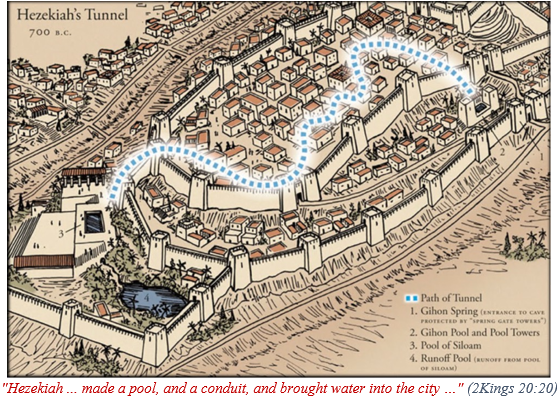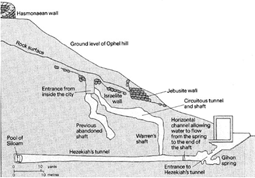What’s a ruler to do when the army of a superpower encircles his city, having captured 46 other cities across his nation, and threatens to kill it with thirst and famine? No, this isn’t Kyiv; it’s ancient Jerusalem, and king Hezekiah’s solution was simple but hard: cover and protect the Gihon springs outside the city walls, then dig a channel underground all the way to the Siloam pool (see picture below). [1] Quickly. Like. Now.

This tunnel, Hezekiah’s crowning achievement per 2 Chronicles 32:30, was discovered in 1838 by Biblical scholar Edward Robinson. Even back then, it still had over 4-feet of water depth flowing. Today it’s only knee deep in most places. It took Ed 4 hours to traverse; today, 40 minutes.
Yet it was 16-year-old Jacob Eliahu who found its most famous artifact while skipping classes in 1880. Using makeshift floats, he entered the tunnel with candles and matches tied to his neck. When his feeble lamps were snuffed, in total darkness and up to his chin in muddy water, he felt some chisel marks on a submerged wall, 20 feet from the end of the tunnel. Excited, he ran back to tell his school’s headmaster – and it caused quite the stir. When word got out, vandals sloppily cut the ~18”x30” inscription off the wall and sold it on the Israeli Antiquities market. Palestine’s ruling Ottoman Turks confiscated it and sent it to the Istanbul Archaeology Museum in 1891, where it remains today. [2]
 The Siloam Inscription (right) dates to the eighth century (700 BC) based on its grammar, spelling, and paleography (letter style). It refutes all claims from those who deny the significance of Judah’s monarchal period. The 6-line commemoration translates as: “... the tunnel ... and this is the story of the tunnel. While ... the axes were against each other and while three cubits [were left] to cut ...the voice of a man ... called to his fellow, for there was a through-passage in the rock, from the right ... and on the day of the tunnel [being finished] the stone hewers struck [literally “hit”] each man towards his fellow, ax against [literally: “on”] ax, and the water went from the source to the pool for two hundred and a thousand cubits and one hundred(?) cubits was the height over the head of the stone hewers.”
The Siloam Inscription (right) dates to the eighth century (700 BC) based on its grammar, spelling, and paleography (letter style). It refutes all claims from those who deny the significance of Judah’s monarchal period. The 6-line commemoration translates as: “... the tunnel ... and this is the story of the tunnel. While ... the axes were against each other and while three cubits [were left] to cut ...the voice of a man ... called to his fellow, for there was a through-passage in the rock, from the right ... and on the day of the tunnel [being finished] the stone hewers struck [literally “hit”] each man towards his fellow, ax against [literally: “on”] ax, and the water went from the source to the pool for two hundred and a thousand cubits and one hundred(?) cubits was the height over the head of the stone hewers.”
 Modern engineers offer additional insights (left). The tunnel’s width is only a shoulder wide. The noted length of 1,200 cubits (1,800 feet) is accurate. At 100 cubits (150 feet) below surface, and a ceiling in some places only 6 feet high, meant the workers would have excavated in poorly lit, damp, and cramped conditions. It likely took 6-8 months to dig, with crews working at each end. The men, following a subterranean crack, apparently lost their bearings and dug a large S-shaped path. The water tunnel still functions to this day.
Modern engineers offer additional insights (left). The tunnel’s width is only a shoulder wide. The noted length of 1,200 cubits (1,800 feet) is accurate. At 100 cubits (150 feet) below surface, and a ceiling in some places only 6 feet high, meant the workers would have excavated in poorly lit, damp, and cramped conditions. It likely took 6-8 months to dig, with crews working at each end. The men, following a subterranean crack, apparently lost their bearings and dug a large S-shaped path. The water tunnel still functions to this day.
And Jacob the discoverer? An orphaned child, he was adopted by Horatio Spafford, who wrote the hymn, “It Is Well With My Soul”.
[2] Jacob’s discovery details: https://www.itsgila.com/highlightsinscription.htm
Like this? Consider sharing it to Facebook by clicking the linked icon below.
